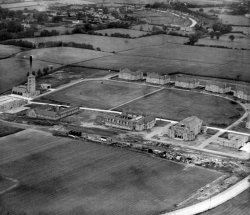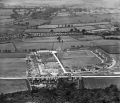Royal Eastern Counties Hospital
| Royal Eastern Counties Hospital | |
|---|---|
 | |
| Opened | 1859 |
| Closed | 1985 |
| Current Status | Demolished |
| Building Style | Cottage Plan |
| Location | Colchester |
| Alternate Names |
|
History[edit]
In 1850 the former hotel south of the main railway station was, with the help of its owner S. M. Peto, converted into a branch asylum of Park House hospital for idiots, Highgate, and 28 children were sent there from London. The number of mentally handicapped patients at the branch asylum, called Essex Hall, had increased to 150 by 1855 with an additional 50 accommodated elsewhere in Colchester, but between 1855 and 1858 all the patients were transferred to the newly built Royal Earlswood hospital, Surrey. In 1859 a separate Eastern Counties' asylum for idiots and imbeciles was established, based at Essex Hall, only the second such institution in England. It received voluntary subscriptions and contributions from some patients, and served Essex, Norfolk, Suffolk, and Cambridgeshire. Patients, mainly but not exclusively children, were admitted by votes of subscribers and no paupers were allowed. The average number of resident patients gradually increased from 66 in 1862 to 189 in 1891 and to 245 in 1897. Patients were accepted for five years, and after 1865 up to 20 per cent of cases could be re-selected to give them a permanent home. Before the institution was handed over to the National Health Service in 1948, Essex, Norfolk, Suffolk, and Cambridgeshire county councils contributed towards the costs of their own patients.
From the beginning the regime was claimed not to be merely custodial but to emphasise training and teaching. In 1862 a cottage was built on the lawn near the main building to provide special care for c. 20 children. Some of the higher-grade patients were instructed in reading, writing, and arithmetic; others worked at tailoring, housework, gardening, and, from 1863, in the specially equipped laundry. Recreations included cricket, football, croquet, keeping animals, and watching magic lantern shows. In 1867 a detached wooden building was built for infectious patients. A new laundry was built c. 1882, and in 1883 a new recreation hall. In the 1890s patients made all staff uniforms, repaired shoes, clothing, and bedding, did carpentry, and made mats and mattresses. Poplar's Hall, a small farm opposite Essex Hall, was leased in 1892 and bought in 1895; cows and other livestock were provided, so that men and boys could do farm work. A seaside home, Crossley House at Clacton, was acquired in 1894 with financial help from Sir Savile Crossley, of Somerleyton.
In 1901 the Peckover schools, given by A. Peckover, lord lieutenant of Cambridgeshire, were opened on an adjoining site; they contained classrooms and workshops. Essex Hall was extended in 1903 to provide an additional 20 beds. A new block, Bristol House, named after Frederick William John, marquis of Bristol (d. 1907), a previous chairman, was opened in 1915 for another 100 patients. By that date the asylum was called the Royal Eastern Counties' institution for the mentally defective. In 1916 Hillsleigh House, East Hill, was bought to house 34 patients, and in 1918 Lexden House was leased as a school for high grade females, increasing the institution's beds to 630. Greenwood school, Halstead, was opened for 86 girls in 1922, enabling Lexden House to become a hostel; about the same time East Hill House was obtained as an upper boys' school, and Hillsleigh was then used as a school for the younger boys. In 1923 Bridge Home, Witham, was bought to provide 233 beds for patients from the institution.
In 1935 eight villas for male patients were opened at Turner village in Turner Road, Mile End, with workshops, assembly hall, kitchen, laundry, administrative buildings, and playing fields; they were named after the Turner family whose members, notably J. J. C. Turner (d. 1913) had been closely involved with Essex Hall. From that date Essex Hall with the Peckover schools was used for female patients. The institution then had 1,850 beds in its different centres, a boys' school at Littleton House and a home for young women at Great West Hatch, Chigwell, having been added. In 1946 a large modern hospital was completed at Turner village to serve the whole institution, and the hospital's administrative centre moved from Essex Hall to Abbeygate House, St. John's Green, where it remained until it moved c. 1972 to new headquarters opposite Turner village. In 1947 Handford House, Ipswich, was acquired for 22 female patients, and Kingsmead at Lexden for a girls' hostel. Handford House was replaced c. 1970 by no. 1 Queen's Road, Colchester, which was used for the elderly mentally handicapped in 1989.
Two additional villas were opened at Turner village in 1964 providing another 100 beds. In 1975 a 28-bed unit was built in the grounds of Lexden House off Cooks Lane. An educational adventure playground of 4 a. for the mentally handicapped was created at Turner village in 1977. Between c. 1950 and the early 1980s Barker House, Clacton-on-Sea, was used as a holiday home, and Brunswick House, Mistley, was used from c. 1950 to c. 1986 as a male hostel. Essex Hall was closed and demolished in 1985, and its 12 a. site sold in 1988. Many patients had by then been moved out into the community, some to group homes, and only 640 patients remained at Turner village. The home at Lexden House was closed in 1990.[1]
